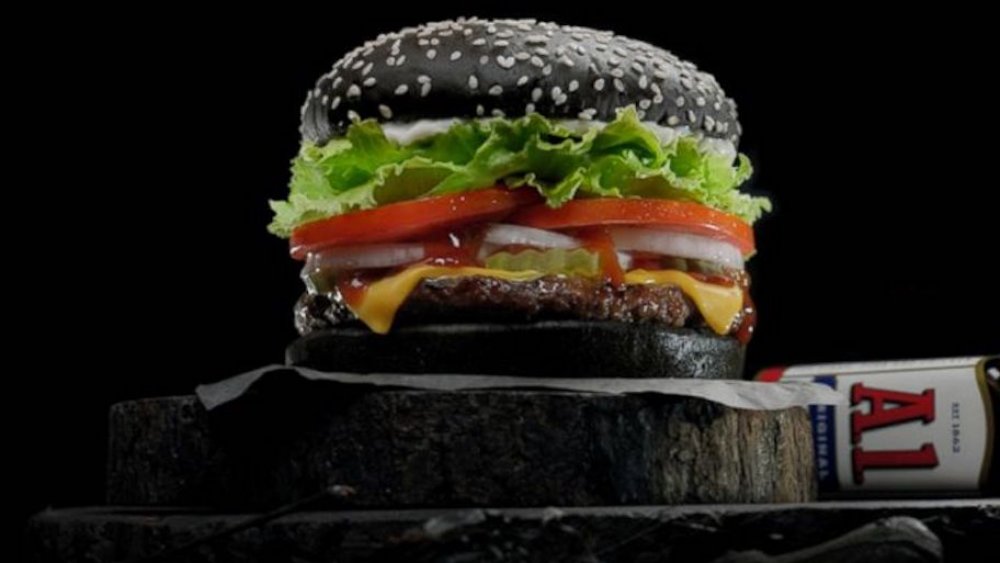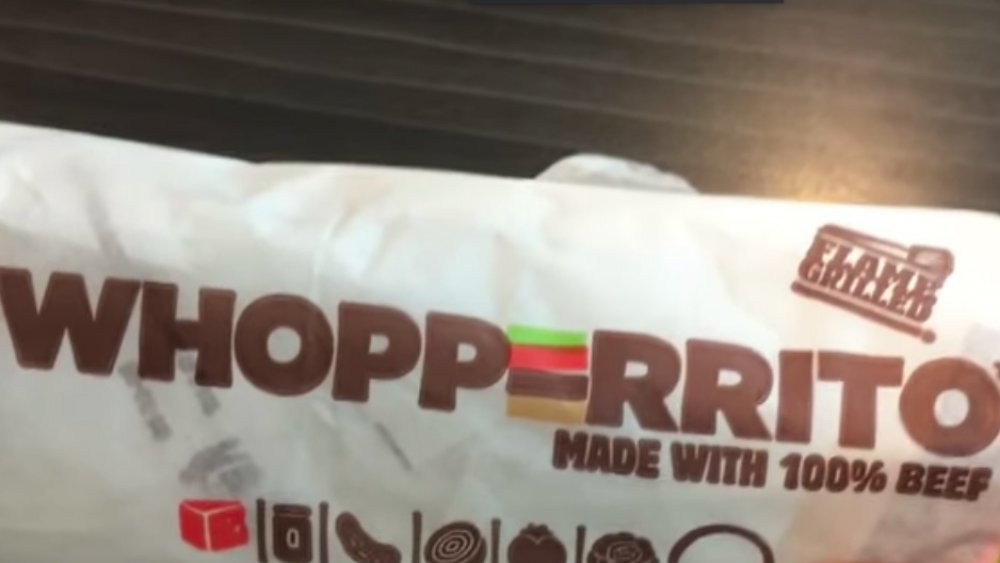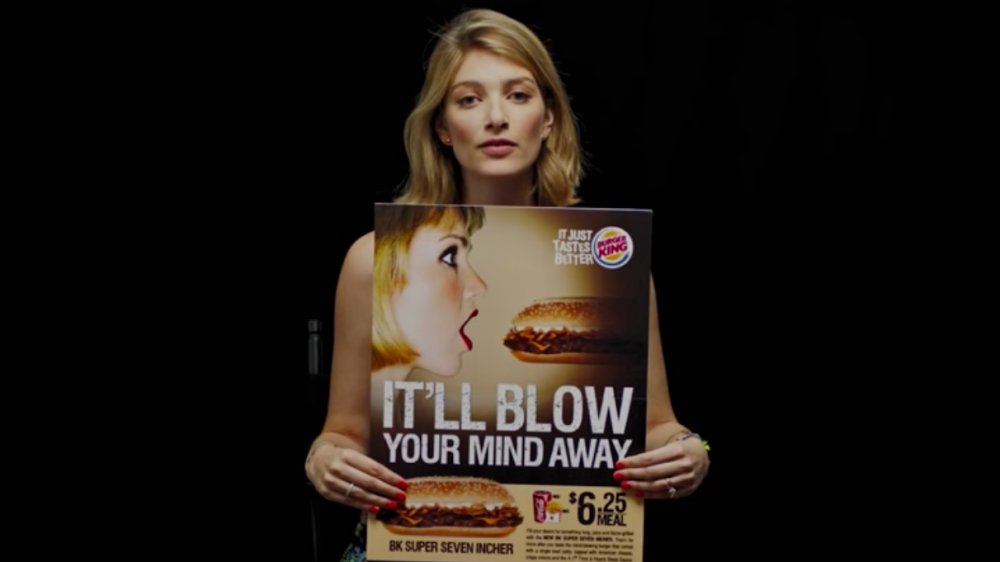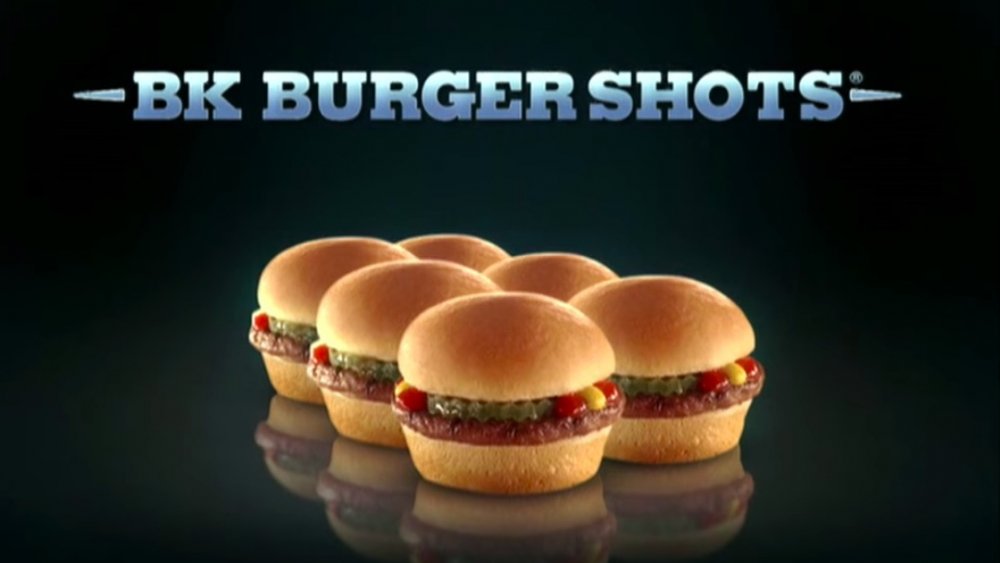The Biggest Flops In Burger King History
Burger King is known as "home of the Whopper," and there's no denying the fast-food chain's signature hamburger has been a longtime favorite with consumers. Yet despite the millions of Whoppers sold each year to hungry customers, not every item introduced by Burger King has proven to be a hit; some, in fact, have been spectacular failures, unleashed onto an unwitting public who took a bite and said, "Nope."
Of course, Burger King can't be blamed for wanting to increase its market share, given that McDonald's remains the true king of burgers. In fact, as of 2019, McDonald's brand was valued at more than $130 billion, while Burger King came in at a far less $7.1 billion.
Burger King isn't the first, last, or only fast-food outlet to introduce experimental dishes that nobody wanted, but they've had some pretty epic fails over the years. From a breakfast sandwich that contained enough calories to feed an entire family to an ill-conceived Halloween-themed burger that gave diners a shocking surprise, these are the biggest flops in Burger King history.
Burger King's Halloween Whopper had a gross side effect
In 2015, Burger King executives decided to celebrate Halloween with a spooky new spin on its classic Whopper: the Halloween Whopper, with the burger boasting a scary-looking dyed-black bun.
Consumers who sampled the novelty burger experienced a very weird surprise when they hit the bathroom and discovered an unexpected side effect: it had turned their bowel movements green. While reports of green poop flooded social media, the burger became less known for its Halloween theme than its colorful after-effects.
The question people began to ask was why a black bun would turn feces green and not black? Gastroenterologist Dr. Ian Lustbader offered an explanation, telling CBS News the food coloring used to turn the bun black was the culprit. Food coloring that isn't entirely absorbed by food material in the gut, he explained, will pass through the digestive tract. Because Burger King already adds dyes to its regular buns, those existing dyes apparently combined with the black dye and then mixed with the stomach's yellow-green bile to result in green poop. Due to the negative buzz, Burger King declined to scare up the Halloween Whopper the following year (but it wasn't the last time they used dyes with odd effects).
Sales of Burger King's Whopperito were not muy caliente
While Taco Bell was enjoying success with its Mexican-inspired fast-food fare, Burger King viewed another piece of market share it could snag from a competitor. In putting on their corporate thinking caps, an idea emerged: the Whopperito. Launched in 2016, the Whopperito contained all the stuff crammed into a traditional Whopper (beef, onions, tomatoes, lettuce and pickles), but instead of a bun the whole thing was wrapped up in a tortilla. The other big change was that the condiments (usually ketchup, mustard and mayonnaise) were substituted with cheesy queso sauce.
Was it a good idea? Not according to Newsweek, which viciously lambasted the Whopperito as being "as disgusting as it looks." At the time, however, Burger King North America president Alex Macedo thought they were really onto something. "We know Tex-Mex is growing a lot... and there are not that many national chains that sell burritos," Macedo told Business Insider. "For us, a burrito works well because we get a vast majority of our sales through the drive-thru, and this is something that's portable."
Trying to please fans of both burritos and burgers resulted in an oddball product that was neither, and Burger King ultimately bid the Whopperito adios.
Burger King's Dinner Baskets tanked
In 1992, Burger King execs had a notion that classing up the joint would bring in more customers. As a result, the chain began offering table service at its restaurants each day between 4 p.m. and 8 p.m., with servers bringing meals right to the table, where customers were invited to snack on free popcorn while they waited for their fast food to arrive... slowly.
There was, however, a hidden agenda lurking behind Burger King's table service, and they were called Dinner Baskets. These all-in-one meals were served in baskets, reported the Morning Call, with options including a Whopper, crispy chicken filet, a steak sandwich and fried shrimp, with the option to substitute a baked potato for fries along with coleslaw or a side salad.
"With the table service and new dinner entrees, we are reaching out to a consumer segment that may not have before come to a fast-food restaurant," said Burger King spokesman Michael Evans of the Dinner Baskets, which were the subject of an advertising campaign featuring MTV personality Dan Cortese.
Dinner baskets and the associated table service at a fast food place, unsurprisingly, weren't widely embraced by consumers looking for fast food. They were eventually discontinued.
Burger King's Flame-Broiled Meatloaf went down in flames
Around the same time as the table service/dinner baskets debacle, Burger King introduced its Flame-Broiled Meatloaf Sandwich. Consumers first learned about the new sandwich from a series of TV commercials featuring such celebs as former MLB player/Mr. Belvedere star Bob Uecker and MTV personality Dan Cortese, best remembered for wearing a baseball cap turned backward while yelling directly into the camera. "Wendy's doesn't have it, McDonald's doesn't have it," declared Cortese in one spot extolling the virtues of flame-broiled meatloaf.
Uecker was also featured in a commercial hawking the Flame-Broiled Meatloaf Dinner Basket, which managed to combine two of Burger King's fast-food failures into one big, fat mega-bust. Go figure, but consumers apparently weren't looking for a new menu item that may have made them feel like they were eating a sandwich made from leftovers.
The Burger King Flame-Broiled Meatloaf sandwich ultimately suffered the same fate as the table service and the dinner baskets. Burger King eventually moved on from pitchmen Uecker and Cortese, as well as the chain's weird MTV-inspired "BK Tee Vee" branding meant to scream, "Hey kids, meatloaf is rad!"
Controversy killed Burger King's Super Seven Incher
There's an old advertising axiom that "sex sells." It is, however, possible to push the envelope too far, which Burger King discovered disastrously when it launched its Super Seven Incher burger in 2009. The burger's moniker was an obvious double entendre, and the ad campaign really ran with it, featuring a model in profile, her eyes wide and her mouth even wider as she prepared to swallow the massive phallic sandwich.
Just in case that wasn't clear enough, Burger King helpfully spelled it out. "It'll blow your mind away," read the ad copy in huge print. And if anyone still didn't get the reference, noted the Wall Street Journal, the fine print made it even more blatant, referencing a "mind-blowing burger" that promised to "fill your desire for something long, juicy and flame grilled." The backlash was severe, leading Burger King to shelve the ad and quietly banish the Super Seven Incher from menus.
The controversy resurfaced several years later, when the model in the ad said she was unaware that the photos she were posing for would be used in such a suggestive manner and accused the company of "publicly humiliating" her.
Burger King's mood-themed Real Meals made nobody happy
Imagine being a fly on the wall in the Burger King meeting where they came up with the idea of ripping off McDonald's iconic Happy Meals, but relating them to different emotions while also folding the whole thing into an ad campaign to raise awareness for mental health.
Real Meals, reported Independent, were introduced in 2019 to coincide with Mental Health Awareness Month, with each boxed-up Burger King combo representing a different mood. Feeling salty? DGAF (don't give a f***)? Burger King had the meal to match the mood.
The commercials were brutal. A depressed dude in a sad little room sits on his tiny single bed and declares, "Not everybody wakes up happy. Sometimes you feel sad, scared, crappy..."
A gold star for anyone who guessed that Real Meals were eviscerated on social media, and the sarcasm was intense. One tweeter congratulated Burger King for "ending mental illness the same way Kendall Jenner and Pepsi ended racism," referencing another disastrous ad campaign. Another wrote, "Just punched a hole in my wall thinking about all the money I could have saved last year by just having Burger King instead of having to go to the psychiatric hospital."
Burger King's "healthy" Satisfries satisfied no one
In 2013, health was top of mind for many people, which wasn't great for fast-food retailers. Sensing an untapped market in offering healthier fare to the type of people who normally eschew fast food, or by providing less-fattening alternatives to customers who loved fast food but wanted to drop a few pounds, Burger King introduced Satisfries. Billed as containing 40 percent less fat and 30 percent fewer calories, Burger King surely saw Satisfries as an opportunity to entice health-conscious consumers into sampling a guilt-free French fry.
A seemingly solid strategy, but in practice... not so much. As Crain's Chicago Business reported, Satisfries bombed big time. Bob Goldin, executive vice president at Chicago-based researcher Technomic Inc., hit the nail on the head when he explained why the product was doomed from the get-go. Healthy menu items at fast-food restaurants, he explained, target a "very narrow audience," illustrating an important truism: people consumed with health will rarely eat fast food, and people who eat fast food are clearly not over-concerned with health. "French fries are an indulgence, just like ice cream," said Goldin. "You don't eat them if you're worried about your diet."
Burger King's Enormous Omelette Sandwich had more calories than the Whopper
By the mid-2000s, breakfast was a fast-food battleground. McDonald's had a solid foothold in the category with its iconic Egg McMuffins when Burger King came up with a breakfast sandwich that would hopefully dethrone the McMuffin. This product was the Enormous Omelet Sandwich, which boasted a two-egg omelet topped with two slices of American cheese, a sausage patty and three thick strips of bacon, piled high on a hoagie-style bun.
Those who dug into the sandwich's nutritional information came away with some fun facts, reported NBC News. With more calories that the Whopper (730 calories vs. the Whopper's puny 700), the Enormous Omelet Sandwich contained a whopping 47 grams of fat. "By expanding our indulgent breakfast sandwich menu, Burger King restaurants now offer even more alternatives for our guests who want a convenient and filling breakfast," said Russ Klein, Burger King's chief global marketing officer, at the time.
Fast food consumers clearly love a hearty breakfast, but apparently drew the line at a sandwich that should have been sold with a defibrillator on the side. The BK Enormous Omelet was discontinued and never heard from again.
Consumers weren't shook by Burger King's Shake 'Em Up Fries
In 2002, Burger King decided to shake things up with its Shake 'Em Up Fries. The concept was pretty basic, simply the chain's regular fries served in a bag, along with a "Cheezy Flavor Blast" packet that was meant to be sprinkled in the bag. Customers would simply seal up the bag, give the fries a vigorous shaking to coat the fries and then chow down.
A commercial for the new product demonstrated the shaking technique, featuring an array of youngsters agitating their fry-filled bags and then eating the bright-orange potato sticks that emerged. Shake 'Em Up Fries did not make as much of an impact on the marketplace as Burger King had hoped, and were eventually discontinued.
Despite the product's failure, McDonald's was reportedly developing an similar flavored french fry in 2014. As Foodbeast reported, McDonald's tested its seasoned fries in a California location, and shared some photos of the bag. Not only was the product similar, it was pretty much the exact same process — fries in a bag, add seasoning, shake and eat. That test was presumably not a success, as the product was never rolled out nationally.
Burger King's Burger Buddies were a bust
As Delish recalled, in the 1980s Burger King had apparently grown envious of the success that White Castle had been experiencing with its little mini-sized burgers, and saw an opportunity to grab a piece of the tiny-burger market share. The result was Burger Bundles, basically a Burger King take on sliders. According to the Christian Science Monitor, they were sold in a "bundled" packs of six, hence the name.
When it came to broiling the small burgers, there was a big problem. As Nation's Restaurant News, reported, the patties were so small they reportedly had a tendency to slip through the broiler grates and were constantly getting ruined. The teeny little burgers were later discontinued, leaving White Castle as the true king when it came to undersized burgers.
While Burger King Bundles may have been lost to the sands of time (with the exception of a few attempts at re-release), a vintage commercial remains, indicating "these tasty little guys" were the perfect grab-and-go snack for eating on the run.
BK Burger Shots were shot down
Burger King's Burger Bundles may have died off, but the idea for tiny hamburgers did not. That became apparent in 2008 when the chain introduced BK Burger Shots, which were identical to their predecessors in everything other than one: coupled buns were attached to each other, resulting in small conjoined hamburgers. As Nation's Restaurant News wrote at the time, the mini-burgers were billed as a "limited-time offer" in certain US locations as a test. The move reportedly came after Burger King successfully launched the same product in restaurants throughout the United Arab Emirates, called Burger Buddies, which were sold in six-packs.
Given that Burger Shots were taken off the menu, one reason for the product's failure may have been the bizarre advertising campaign used to sell them. One commercial was creepy bordering on disturbing, opening with a jerky, handheld camera focusing on a sleeping guy. An arm enters the frame, blasting an airhorn next to the sleeper's head. The frightened dude jumps out of bed startled, only be tackled by another guy, presumably a "friend." Meanwhile, the prankster with the airhorn is revealed to be Burger King's plastic-headed King mascot, doubled over in laughter. That doesn't leave us begging for tiny burgers — how about you?
Burger King hot dogs received a cold reception
Hot dogs and hamburgers have gone hand-in-hand at backyard barbecues for decades, so why wouldn't that also be the case at Burger King? The fast-food chain decided to find out in 2016 by launching Grilled Dogs, introducing the hot dogs to its permanent menu. According to Newsweek, the dogs were available in a standard variety as well as a chili cheese version. "The introduction of Grilled Dogs just made sense to our guests and for our brand," said Burger King North America president North Alex Macedo in a statement.
Burger King was apparently quite bullish on its dogs. In fact, the chain hired rapper Snoop Dogg and "coochie-coochie" queen Charo to star in humorous ads meant to look like training videos to instruct staff in the proper preparation of the dogs. As Time reported, the "Gin & Juice" rapper was billed as a "Grilled Dogs Training Ambassador," who instructs trainees to put some pretty strange toppings on the wieners. "Break out the burners 'cause we grillin' this dog my way — bikinis, martinis, zucchinis, yeah, you know the rest," he raps to trainees.
The Burger King turkey burger was was not gobbled up
Health and wellness was top of mind for many people during the 2010s, which wasn't exactly good news for companies selling high-calorie fast food. In an attempt to offer something approaching healthy, in 2013 Burger King decided to offer a turkey burger. "Turkey burgers as a category is growing pretty rapidly in the restaurant space," Eric Hirschhorn, Burger King's head of global innovation, told CBS News.
Of course, just because Burger King substituted turkey for beef didn't mean the burger was particularly less caloric than its regular offerings. As CBS News pointed out, the Burger King turkey burger contained a hefty 530 calories — only 100 calories less than a Whopper, and more than the chain's grilled chicken sandwich, which contained 470 calories.
While Wendy's and McDonald's — Burger King's chief competitors — reportedly had no plans to offer turkey burgers, smaller chains Carl's Jr. and Hardee's had successfully experimented with offering turkey burgers, and found them so popular that both chains kept them on the menu. This was not the case for Burger King's version, which, like an actual turkey, was unable to take flight.
Burger King's artery-clogging Pizza Burger was like accepting a dare
People like burgers. People like pizza. Given that knowledge, one would assume combining the two would be a home run. That was clearly the thinking that resulted in the New York Pizza Burger. As Salon reported, the new product was launched as a special offering at the chain's locations in New York.
In truth, the item was more burger than pizza — essentially a giant hamburger with pizza-style toppings including pepperoni, mozzarella cheese, pesto, and marinara sauce crammed into a nine-and-a-half-inch sesame seed bun. This super-sized burger was then cut into sections and shared like a pizza, designed to feed six.
The New York Pizza Burger was the creation of Burger King head chef J Sullivan, who described the monstrous meal as a "fast food translation of the locavore movement," which aims to connect food producers and food consumers in the same geographic locale. However, as The Telegraph pointed out, Burger King's New York Pizza Burger was not for the weak of heart — literally, given that it clocked in at an artery-clogging 2,500 calories.














